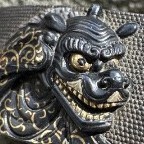Hi! Brian said it quite accurately.
The mei can be in different places, sometimes even on a plate of pure gold inside.
However, as with other tosogu items, it all comes down to the quality of the craftsmanship. The more intricate the work, the more likely it is that it was created by a renowned master who may have included a mei. In most cases, mei signatures are not present, which is normal. This item is genuine. Menuki are less likely to be counterfeited, and you can easily identify them.


